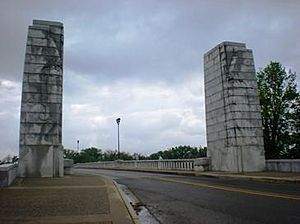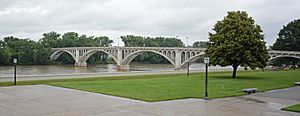Lincoln Memorial Bridge facts for kids
Quick facts for kids Lincoln Memorial Bridge |
|
|---|---|
 |
|
| Coordinates | 38°40′54″N 087°32′07″W / 38.68167°N 87.53528°W |
| Carries | |
| Crosses | Wabash River |
| Locale | Vincennes, Indiana / Lawrence County, Illinois |
| Characteristics | |
| Design | Deck Arch |
| Total length | 1,065.6 feet |
| Width | 22.0 feet |
| Longest span | 189.9 feet |
| History | |
| Opened | September 3, 1933 |
The Lincoln Memorial Bridge is a special bridge that connects Vincennes, Indiana, and Lawrence County, Illinois. It carries U.S. Route 50 Business over the wide Wabash River. This bridge is famous because it's believed to be where a young Abraham Lincoln crossed the river in 1830 on his way to Illinois.
Contents
About the Lincoln Memorial Bridge
This bridge is known as a "deck arch bridge." This means its main support structure is an arch that holds up the road above it. The Lincoln Memorial Bridge was opened on September 3, 1933. It helps people travel easily between Indiana and Illinois.
Lincoln's Journey and the Memorial
The bridge gets its name from Abraham Lincoln, who later became a very important U.S. President. In 1830, when he was a young man, Lincoln and his family moved from Indiana to Illinois. The bridge is said to mark the exact spot where he crossed the Wabash River. To remember this important journey, there is a special sculpture called the Lincoln Trail State Memorial at the western end of the bridge.
The Bridge's Design and Features
The Lincoln Memorial Bridge is 1,065.6 feet long, which is about the length of three football fields! It is 22 feet wide. The main part of the bridge, called the mainspan, stretches 189.9 feet. It is a strong and lasting structure made of concrete.
Lincoln Memorial Bridge Pylons
The Lincoln Memorial Bridge Pylons are tall, decorative pillars found at the entrance to the bridge. They are a public artwork created by a French artist named Raoul Josset. These pylons are located on the grounds of the George Rogers Clark National Historical Park.
Artwork on the Pylons
The pylons are made of granite, a very strong stone. On the front of each pylon, there are detailed carvings, called reliefs. These carvings show two full-length figures of Native American chiefs.
The figure on the southern pylon is dressed in special ceremonial clothing. He holds a club in his right hand. The figure on the northern pylon is also dressed in similar clothing and holds a blanket. The artist, Raoul Josset, signed his name on the south side of the right carving. These impressive pylons were installed in 1936.


